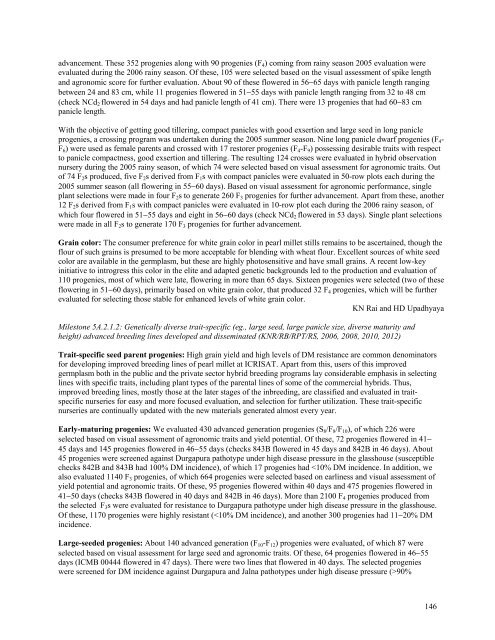ICRISAT Archival Report 2006 - The seedlings of success in the ...
ICRISAT Archival Report 2006 - The seedlings of success in the ...
ICRISAT Archival Report 2006 - The seedlings of success in the ...
Create successful ePaper yourself
Turn your PDF publications into a flip-book with our unique Google optimized e-Paper software.
advancement. <strong>The</strong>se 352 progenies along with 90 progenies (F 4 ) com<strong>in</strong>g from ra<strong>in</strong>y season 2005 evaluation were<br />
evaluated dur<strong>in</strong>g <strong>the</strong> <strong>2006</strong> ra<strong>in</strong>y season. Of <strong>the</strong>se, 105 were selected based on <strong>the</strong> visual assessment <strong>of</strong> spike length<br />
and agronomic score for fur<strong>the</strong>r evaluation. About 90 <strong>of</strong> <strong>the</strong>se flowered <strong>in</strong> 56−65 days with panicle length rang<strong>in</strong>g<br />
between 24 and 83 cm, while 11 progenies flowered <strong>in</strong> 51−55 days with panicle length rang<strong>in</strong>g from 32 to 48 cm<br />
(check NCd 2 flowered <strong>in</strong> 54 days and had panicle length <strong>of</strong> 41 cm). <strong>The</strong>re were 13 progenies that had 60−83 cm<br />
panicle length.<br />
With <strong>the</strong> objective <strong>of</strong> gett<strong>in</strong>g good tiller<strong>in</strong>g, compact panicles with good exsertion and large seed <strong>in</strong> long panicle<br />
progenies, a cross<strong>in</strong>g program was undertaken dur<strong>in</strong>g <strong>the</strong> 2005 summer season. N<strong>in</strong>e long panicle dwarf progenies (F 4 -<br />
F 6 ) were used as female parents and crossed with 17 restorer progenies (F 4 -F 9 ) possess<strong>in</strong>g desirable traits with respect<br />
to panicle compactness, good exsertion and tiller<strong>in</strong>g. <strong>The</strong> result<strong>in</strong>g 124 crosses were evaluated <strong>in</strong> hybrid observation<br />
nursery dur<strong>in</strong>g <strong>the</strong> 2005 ra<strong>in</strong>y season, <strong>of</strong> which 74 were selected based on visual assessment for agronomic traits. Out<br />
<strong>of</strong> 74 F 2 s produced, five F 2 s derived from F 1 s with compact panicles were evaluated <strong>in</strong> 50-row plots each dur<strong>in</strong>g <strong>the</strong><br />
2005 summer season (all flower<strong>in</strong>g <strong>in</strong> 55−60 days). Based on visual assessment for agronomic performance, s<strong>in</strong>gle<br />
plant selections were made <strong>in</strong> four F 2 s to generate 260 F 3 progenies for fur<strong>the</strong>r advancement. Apart from <strong>the</strong>se, ano<strong>the</strong>r<br />
12 F 2 s derived from F 1 s with compact panicles were evaluated <strong>in</strong> 10-row plot each dur<strong>in</strong>g <strong>the</strong> <strong>2006</strong> ra<strong>in</strong>y season, <strong>of</strong><br />
which four flowered <strong>in</strong> 51−55 days and eight <strong>in</strong> 56−60 days (check NCd 2 flowered <strong>in</strong> 53 days). S<strong>in</strong>gle plant selections<br />
were made <strong>in</strong> all F 2 s to generate 170 F 3 progenies for fur<strong>the</strong>r advancement.<br />
Gra<strong>in</strong> color: <strong>The</strong> consumer preference for white gra<strong>in</strong> color <strong>in</strong> pearl millet stills rema<strong>in</strong>s to be ascerta<strong>in</strong>ed, though <strong>the</strong><br />
flour <strong>of</strong> such gra<strong>in</strong>s is presumed to be more acceptable for blend<strong>in</strong>g with wheat flour. Excellent sources <strong>of</strong> white seed<br />
color are available <strong>in</strong> <strong>the</strong> germplasm, but <strong>the</strong>se are highly photosensitive and have small gra<strong>in</strong>s. A recent low-key<br />
<strong>in</strong>itiative to <strong>in</strong>trogress this color <strong>in</strong> <strong>the</strong> elite and adapted genetic backgrounds led to <strong>the</strong> production and evaluation <strong>of</strong><br />
110 progenies, most <strong>of</strong> which were late, flower<strong>in</strong>g <strong>in</strong> more than 65 days. Sixteen progenies were selected (two <strong>of</strong> <strong>the</strong>se<br />
flower<strong>in</strong>g <strong>in</strong> 51−60 days), primarily based on white gra<strong>in</strong> color, that produced 32 F 4 progenies, which will be fur<strong>the</strong>r<br />
evaluated for select<strong>in</strong>g those stable for enhanced levels <strong>of</strong> white gra<strong>in</strong> color.<br />
KN Rai and HD Upadhyaya<br />
Milestone 5A.2.1.2: Genetically diverse trait-specific (eg., large seed, large panicle size, diverse maturity and<br />
height) advanced breed<strong>in</strong>g l<strong>in</strong>es developed and dissem<strong>in</strong>ated (KNR/RB/RPT/RS, <strong>2006</strong>, 2008, 2010, 2012)<br />
Trait-specific seed parent progenies: High gra<strong>in</strong> yield and high levels <strong>of</strong> DM resistance are common denom<strong>in</strong>ators<br />
for develop<strong>in</strong>g improved breed<strong>in</strong>g l<strong>in</strong>es <strong>of</strong> pearl millet at <strong>ICRISAT</strong>. Apart from this, users <strong>of</strong> this improved<br />
germplasm both <strong>in</strong> <strong>the</strong> public and <strong>the</strong> private sector hybrid breed<strong>in</strong>g programs lay considerable emphasis <strong>in</strong> select<strong>in</strong>g<br />
l<strong>in</strong>es with specific traits, <strong>in</strong>clud<strong>in</strong>g plant types <strong>of</strong> <strong>the</strong> parental l<strong>in</strong>es <strong>of</strong> some <strong>of</strong> <strong>the</strong> commercial hybrids. Thus,<br />
improved breed<strong>in</strong>g l<strong>in</strong>es, mostly those at <strong>the</strong> later stages <strong>of</strong> <strong>the</strong> <strong>in</strong>breed<strong>in</strong>g, are classified and evaluated <strong>in</strong> traitspecific<br />
nurseries for easy and more focused evaluation, and selection for fur<strong>the</strong>r utilization. <strong>The</strong>se trait-specific<br />
nurseries are cont<strong>in</strong>ually updated with <strong>the</strong> new materials generated almost every year.<br />
Early-matur<strong>in</strong>g progenies: We evaluated 430 advanced generation progenies (S 8 /F 8 /F 10 ), <strong>of</strong> which 226 were<br />
selected based on visual assessment <strong>of</strong> agronomic traits and yield potential. Of <strong>the</strong>se, 72 progenies flowered <strong>in</strong> 41−<br />
45 days and 145 progenies flowered <strong>in</strong> 46−55 days (checks 843B flowered <strong>in</strong> 45 days and 842B <strong>in</strong> 46 days). About<br />
45 progenies were screened aga<strong>in</strong>st Durgapura pathotype under high disease pressure <strong>in</strong> <strong>the</strong> glasshouse (susceptible<br />
checks 842B and 843B had 100% DM <strong>in</strong>cidence), <strong>of</strong> which 17 progenies had

















